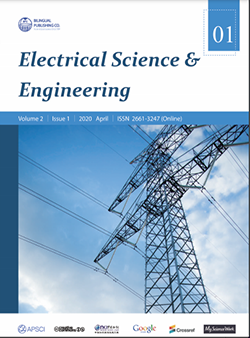-
170
-
159
-
142
-
141
-
131
An Approach to Carbon Emissions Prediction Using Generalized Regression Neural Network Improved by Genetic Algorithm
DOI:
https://doi.org/10.30564/ese.v2i1.1772Abstract
The study on scientific analysis and prediction of China’s future carbonemissions is conducive to balancing the relationship between economicdevelopment and carbon emissions in the new era, and actively respondingto climate change policy. Through the analysis of the application of thegeneralized regression neural network (GRNN) in prediction, this paperimproved the prediction method of GRNN. Genetic algorithm (GA) wasadopted to search the optimal smooth factor as the only factor of GRNN,which was then used for prediction in GRNN. During the prediction of carbon dioxide emissions using the improved method, the increments of datawere taken into account. The target values were obtained after the calculation of the predicted results. Finally, compared with the results of GRNN,the improved method realized higher prediction accuracy. It thus offers anew way of predicting total carbon dioxide emissions, and the predictionresults can provide macroscopic guidance and decision-making referencefor China’s environmental protection and trading of carbon emissions.Keywords:
Carbon emissions; Genetic Algorithm; Generalized Regression Neural Network; Smooth Factor; PredictionReferences
[1] A. Hu, & W Zhang. Major Challenges and Active Responses in the New Era of China. Journal of Beijing Jiaotong University (Social Science Edition), 2018, 17: 1-8.
[2] J. Wu, J. Qu, H. Li, H. Zhang, L. Xu. Practical Research on Multidisciplinary Cooperative Mechanism of Climate Change, Ecological Economy. 2018, 34: 128-133.
[3] J. Pan, X. Zhao. Spatial Difference Modeling of Carbon emissions in China Based on Spatial Regression Model, Journal of Environmental Science. 2018, 27: 131-140.
[4] Y. Wang, Y. Bi, E. Wang. Scenario Prediction and Emission Reduction Potential Assessment of Industrial Carbon emissions Peak in China, China Population, Resources and Environment. 2017, 27: 131-140.
[5] Tulson M., W. Ding, J. Xie. Carbon emissions Prediction and Influencing Factors Analysis Based on Neural Network. Environmental Engineering, 2017, 35: 156-160.
[6] Du Q., Chen Q., & Lu N. (2012) China’s Future Carbon emissions Forecast Based on Improved IPAT Model. Journal of Environmental Science, 32, 2294-2302.
[7] Geoffrey J. B., Richard G. R. Thomas F. Rutherford. Revised Emissions Growth Projections for China: Why Post Kyoto Climate Policy Must Look East. Project on International Climate Agreements, 2008, 3: 1-26.
[8] S. Qu, Z. Guo. Prediction of China’s Peak Carbon emissions Based on STIRPAT Model[J]. China Population, Resources and Environment, 2010, 20: 10-14.
[9] J. Song. Carbon emissions Prediction Model Based on STIRPAT and Partial Least Square Regression[J]. Statistics and Decision-making, 2011, 24: 19-23.
[10] L. Zhang, S. Chen, W. Wang. Measurement and Trend Prediction of Carbon emissions Effect of Construction Land Change in Anhui Province in Recent 15 Years Based on STIRPAT Model[J]. Journal of Environmental Science, 2013, 33: 950-958.
[11] Y. Wang. Evolution and Forecast of Energy Consumption Carbon emissions in Henan Province. Enterprise Economy, 2013, 6: 26-32.
[12] X. Wang, Y. Wang, H. Duan. Prediction and Controllability of Peak Emissions of Regional Energy Consumption. China Population, Resources and Environment, 2014, 24: 9-16.
[13] B. Wei.Scenario Analysis of Energy Demand and Carbon Dioxide Emission in China. Beijing: China Environmental Science Press, 2007: 75-78.
[14] Yongbin Zhu, Zhen Wang, Li. Pang. Peak Forecast of Energy Consumption and Carbon emissions in China Based on Economic Simulation. Geography Journal, 2009, 8: 935-944.
[15] Sen Bao, Lixin Tian, Junshuai Wang. Prediction of Energy Production and Consumption Trends and Carbon emissions in China. Journal of Natural Resources, 2010, 25: 1248-1253.
[16] Xiaoming Li, Anjian Wang, Wenjia Ding. Global CO2 Emission Trend Analysis Based on Energy Demand Theory. Journal of Earth Science, 2010, 31:741-748.
[17] Aiwen Zhao, Dong Li. Grey Prediction of Carbon emissions in China. Mathematics in Practice and Theory, 2012, 42: 61-69.
[18] Teo Lian Seng, M Khalid, R. Yusof. Adaptive GRNN for the Modeling of Dynamic Plants. Proceedings of the 2002 IEEE International Symposium on Intelligent Control, 2002, 11: 27-30.
[19] Donald F Specht. A General Regression Neural Network. IEEE Transactions on Neural Networks, 1991, 2: 568-576.
[20] Specht D F. The general regression neural network Rediscovered. Sustainable Livestock Production & Human Welfare, 1993, 6: 1033-1034.
[21] Wiener, J.B. Climate change policy and policy change in China. UCLA Law Review, 2008, 55: 1805-1826.
[22] Baareh, A. K. Evolutionary design of a carbon dioxide emission prediction model using genetic programming. CARBON, 2018, 9: 298-303.
[23] Aziz, B., Arina, N., & Yee, C. J. Inventory Routing Problem with Carbon Emission Consideration. Matematika, 2019, 35: 39-49.
[24] Cariou, P., Cheaitou, A., Larbi, R., & Hamdan, S.. Liner shipping network design with emission control areas: A genetic algorithm-based approach, Transportation Research Part D: Transport and Environment, 2018, 63: 604-621.
[25] Nagapurkar, P., & Smith, J. D.. Techno-economic optimization and social costs assessment of microgrid-conventional grid integration using genetic algorithm and Artificial Neural Networks: A case study for two US cities. Journal of Cleaner Production, 2019, 229: 552-569.




 Zhida Guo
Zhida Guo





